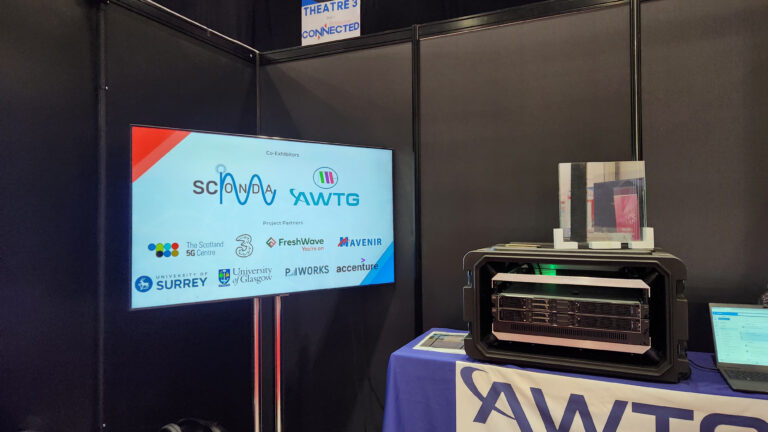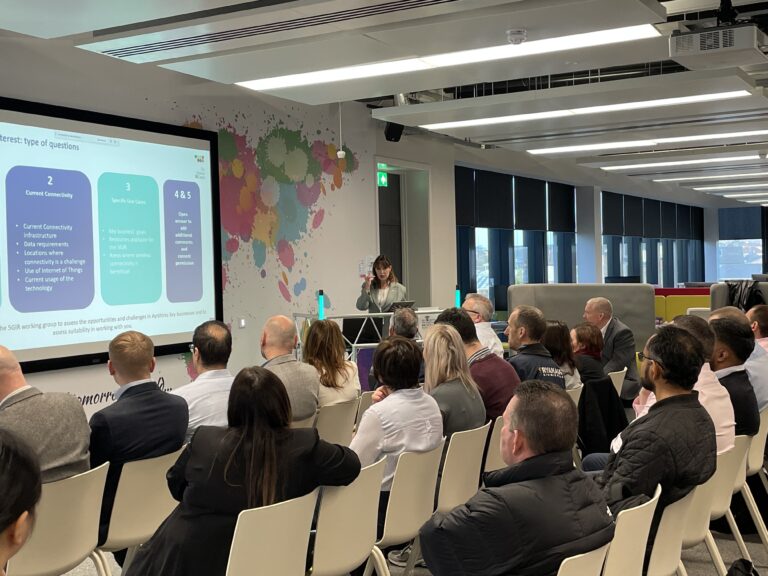News

SCONDA Project Achieve Major Milestones at Connected Britain 2024
Published: 1st October 2024
SCONDA, a multi-million-pound telecoms project funded by the Department for Science, Innovation and Technology (DSIT) and including 9 partners spanning across Telecoms Industry and Academia, marked a significant milestone as Silver Sponsors at Connected Britain 2024, held on 11-12th September at the ExCel Arena, London.
The UK flagship connectivity event provided an invaluable platform for the consortium to showcase its developments. Conference attendees flocked to Booth 159 to engage with the Consortium members and gain deeper insights into the project.
AWTG team, who is spearheading the collaborative effort, presented the vision, goals and objectives.
SCONDA, spearheaded by AWTG and supported/promoted by the Scotland 5G Centre, aims to address the unique technical and commercial challenges of deploying 5G and OpenRAN technologies in high-density demand areas. This pioneering initiative is part of the Open Network Ecosystem Competition launched in 2023 and represents a world-first integration of OpenRAN and Traditional RAN hardware and software in a demanding urban environment like Glasgow city centre Novel technologies such ORAN Small Cells, RIC with built-in Artificial Intelligence, xApps, AWTG’s FlexiRAN and University of Surrey’s Intelligent Reflective Surfaces (both here depicted) have been presented.
The project underscores AWTG’s pivotal role in various DSIT consortiums, where it leverages its expertise in OpenRAN and AI technology to deliver substantial economic and social value.
Highlighting the project’s industry significance, AWTG’s Chief Operating Officer, Ian Vernon, was a featured speaker at the event. Ian Vernon provided a comprehensive overview of the role of OpenRAN in the UK, detailing SCONDA’s objectives, key results, and future plans. His insights resonated with attendees, emphasizing the project’s potential to revolutionise high-density network deployments and setting the stage for future advancements in 5G technology.
In addition to AWTG and the Scotland 5G Centre, the SCONDA project has garnered support from a consortium of influential partners, including Three, Freshwave Group, Mavenir, PI Works University of Surrey, University of Glasgow, and Accenture, and were also present at the Conference. This collaborative effort has not only strengthened the project’s foundation but also facilitated the exchange of knowledge and alignment of goals among partners, promising a transformative impact on the telecommunications landscape. The successful exhibition at Connected Britain 2024 has set a positive trajectory for SCONDA, reaffirming its status as one of DSIT’s innovation and collaboration in the field of 5G and OpenRAN technology.
Mike Carter, AWTG’s Director of Public Networks shares:
Connected Britain 2024 event has been an incredible opportunity for us to showcase the pioneering work we are doing with the SCONDA initiative. Our collaboration with the Scotland 5G Centre and other key partners is driving innovation in 5G and OpenRAN technologies, addressing the complex challenges of high-density network deployments. We’re excited to see how our collective efforts will reshape the telecommunications landscape and bring substantial economic and social benefits.
Luca Campanalonga, Business Development Manager, The Scotland 5G Centre has further expressed:
Connected Britain brought together all the SCONDA partners to showcase the project’s transformative potential in revolutionizing network infrastructure and driving innovation in the telecom industry. Attendees had the opportunity to hear directly from project experts, learn more about the initiative, and additionally, insights into the project’s upcoming milestones offered a glimpse into the future of telecommunications and the broader impact SCONDA will have on digital infrastructure.

Tay5G Challenge Fund 2 Announces Winners for Promising Innovations in Scotland
Published: 1st October 2024
Tay5G, a Tay Cities Region Deal project in collaboration with the Scotland 5G Centre and universities and industry partners, has today announced the winners of its Challenge Fund.
This competitive funding initiative aims to accelerate the development of innovative projects utilising the power of 5G technology to transform various sectors. It has been supported with around £600,000 of Scottish Government funding as part of its £2million investment in Tay5G.
The winners of the challenge are AIX Live Ltd, James Hutton Ltd, JET Connectivity and University of Dundee.
The fund attracted extensive interest and the winners, chosen from a wide range of great ideas, represent a diverse range of innovation. Supported by the adoption of 5G technology, these projects aim to bring about advancements in events and entertainment, agritech, drones for search & rescue and forensic science, delivering tangible benefits to business and communities in Scotland and beyond.
AIX Live, selected for their distributed, collaborative events project, is developing a global network of immersive spaces aimed at “Bringing Immersive to your Neighbourhood.” AIX Live is about creating that moment of shared experience that stays with you long after an event has ended. They are researching how that feeling can be experienced across different spaces by different audiences all at the same time and how the use of immersive technologies can enable that to happen. The success of their business is reliant on achieving a seamless link between technology and live audience experience and they can’t wait to begin this exciting collaboration with the team at Abertay University and CoSTAR Realtime Lab that will focus on a number of innovations in the use of 5G. Abertay leads the Scottish hub of the CoSTAR network – Convergent screen technologies and performance in realtime. AIX Live aims to leverage 5G technology to address challenges like system latency and synchronisation, ensuring seamless, simultaneous experiences across multiple venues and devices as they move towards commercial operations.
James Hutton Ltd is the commercial arm of the James Hutton Institute, a world-leading agriculture and agritech research organisation. Agriculture is currently facing challenges such as labour shortages, fluctuating prices, and the need for climate adaptation, all while maintaining business viability. Robotics, like tractors in the past, has the potential to improve efficiency by reducing labour and inputs while minimizing negative environmental impacts through a data-driven approach. Although autonomous agricultural robots are already available, they require further testing to build farmer confidence. Building on a successful Tay5G Agritech demonstration, this project aims to integrate robotic platforms with 5G capabilities at Mylnefield Farm. Supported by Soil Essentials and The National Robotarium, the project will use 5G’s ultra-reliable, low-latency communications to control autonomous vehicles and gather real-time data, with the goal of establishing a ‘robotics test bed’ for agricultural innovation.
JET Connectivity has developed 5G radio and user equipment designed for rural and hard-to-reach areas, capable of quickly deploying 5G networks powered by solar, hydrogen, or batteries. With experience in delivering 5G for search and rescue and offshore operations, JET aims to provide a pop-up mobile connectivity solution for emergency resilience across the Tay area. This project will explore meshing connectivity between multiple hardware systems, creating a unified network across pop-up sites. Additionally, JET will explore service slicing to prioritise support for emergency responders and the local community. Inspired by the widespread connectivity issues caused by Storm Arwen in 2021, this solution seeks to ensure mobile and broadband access in remote areas without requiring specialist engineers, due to the user friendly approach to the solution and training materials provided during the project.
The University of Dundee’s Leverhulme Research Centre for Forensic Science, funded by the Leverhulme Trust, focuses on improving forensic science for use in civil and criminal courts through interdisciplinary research and collaboration. One key area of focus is creating accurate virtual reality (VR) representations of real environments. Their developed technology has been validated using a specialized facility to simulate crime scenes and generate accurate VR 3D environments. These VR scenes are shared with law enforcement, legal, and forensic practitioners for training and certification. Currently, there is a delay between data collection and VR 3D environment creation, and with new funding, the Centre aims to integrate 5G technology to enhance and streamline this process, advancing it beyond the current state of the art and further demonstrating its operational use.
Tay5G and the Scotland 5G Centre continue to encourage and support the development of innovative 5G projects, fostering Scotland’s position as a leader in technological advancements. By embracing the opportunities presented by 5G, Scotland is set to unlock new possibilities and create a brighter future for its industries and citizens.
Dundee City Council’s Fair Work, Economic Growth and Infrastructure Convener, Councillor Steven Rome, said: “The Tay5G Challenge Fund was designed to help Tay Cities Region growth sectors embrace 5G networks and enhance their businesses.
“The winners of this round have again risen to the task. Each successful project represents genuine innovation with the power to harness the latest connectivity technology and transform sectors of the economy from farming to forensics. They all have real potential, and I look forward to seeing how they develop going forward.”
The Scotland 5G Centre said: “Following the success of last year’s Tay5G Challenge Fund, The Scotland 5G Centre is thrilled to support again this second innovation challenge, which offers a unique opportunity for the region to foster innovation and growth. We look forward to supporting the winners throughout the process, helping them turn their ideas into reality. Participants will gain access to private 5G testbed for on-site testing, benefit from our technical expertise and services, and receive guidance on leveraging 5G technology to its fullest potential. This initiative not only accelerates the development of groundbreaking solutions but also strengthens the region’s position in technological innovation and advanced connectivity capacity in the Tay Cities Digital Infrastructure Strategy.”
For more information about the Tay5G Challenge Fund 2 and the winners of this funding cycle, visit www.tay5g.com
Further information
About the Tay Cities Region Deal
The Tay Cities Region Deal is a partnership between local, Scottish and UK governments and the private, academic and voluntary sectors which seeks to create a smarter and fairer Angus, Dundee, Fife and Perth & Kinross under the headings Inclusive Tay; Innovative Tay; International Tay; Connected Tay and An Empowered Tay.
The Scottish Government and UK Government will each invest up to £150 million in the Tay Cities Region Deal over 10 years, subject to final approval of robust business cases.
As of 30th September 2023, over £231million of Government investment has been approved for release and over 1,400 jobs have been created.
This central investment from both Governments has the potential to lever in £400m of investment over 15 years, of which more than £145million has already been secured by Projects.
Full and further information on the progress the Deal has made to date on securing investment and jobs, can be found within the Annual Performance Report located on the Tay Cities Region Deal website – https://www.taycities.co.uk/publications
Challenge Fund Winners
AIX Live Ltd – https://www.aix.live/
James Hutton Ltd – https://www.huttonltd.com/
JET Connectivity – https://jet-eng.co.uk/
University of Dundee – https://www.dundee.ac.uk / https://www.dundee.ac.uk/leverhulme
The Scotland 5G Centre
The Scotland 5G Centre was set up in 2019 by the Scottish Government, and provides expert support to enable the deployment of 5G technology solutions and impartial technical advice to support our partners’ digital transformation objectives.
The Centre works with a range of organisations including local authorities, businesses and also public sector, to support digital transformation across Scotland. With over five years’ experience of procuring and standing up private 5G networks, it offers support on:
- the procurement and deployment of 5G private networks;
- the development of 5G enabled solutions;
- in the construction of 5G use cases;
- offer insight and guidance to navigate complex challenges that address specific market needs through AWC
The Centre works with partners to ensure that 5G related projects are de-risked, networks and related equipment are optimised and integrated. It builds business digital ecosystems as a local stakeholder and drives digital innovation growth opportunities.
The Scotland 5G Centre is supporting regional innovation programmes across Scotland and also has mobile testing solutions that allow for on-site testing or deployment in remote areas.
More information can be found at https://scotland5gcentre.org/

Ayrshire’s 5G Vision Comes Alive: Exciting Engagement at the Innovation Region Event
Published: 5th February 2024

